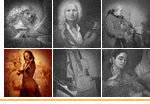ROMANTIC MUSICAL STYLE CHARACTERISTICS
SECTION 4.2
PERFORMING MEDIUM: Chamber music ensembles, large symphony orchestras, opera companies, and piano were the predominant performing mediums during this era.
RHYTHM: Rhythmic complexity and changing tempos were frequently used during the Romantic period. Some music featured strong beats, meter and rhythm, and other compositions employed fluid rhythm and meter that obscured the use of the barline. During this era, the increased technical facility of virtuoso performers led to faster tempos than prior eras.
MELODY: During this period, melodies became subjective, emotional and often were virtuosic (with long runs, arpeggios and ornamentation). Greater technical proficiency by performers led to an expansion in the range of melodies, and changes in dynamics and wide leaps between notes were frequently used to heighten the expressive qualities of the melodies. Many composers also used folk songs or programmatic ideas as the basis for their melodies.
HARMONY: Although a considerable amount of music from this period used traditional harmonies based on major and minor scales, new and complex harmonies were introduced, and harmonic variations such as the use of modulations and chromatic tones were commonplace.
TEXTURE: As in the Classical period, during the Romantic era, homophonic texture was primarily used (melody with accompaniment), and development sections sometimes used polyphonic texture.
FORM: Genres used included large forms from prior eras such as concertos, sonatas, symphonies (often with programmatic titles), and operas. New forms emerged such as character pieces for piano or strings such as the nocturne, waltz, and etude. Other new forms included programmatic works such as symphonic poems and programmatic pieces.
© Copyright 2024 RK Deverich. All rights reserved.
*Although this online viola class is provided free of charge, all rights are reserved and this content is protected by international copyright law. It is illegal to copy, post or publish this content in any form, and displaying any of this material on other websites, blogs or feeds is prohibited. Permission is given for individual users to print pages from this website for their personal, non-commercial use.


